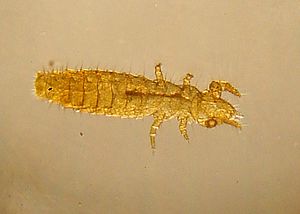Entognatha facts for kids
Quick facts for kids Entognatha |
|
|---|---|
 |
|
| A Proturan specimen (Acerentomon sp.) | |
| Scientific classification | |
| Kingdom: | |
| Phylum: | |
| Subphylum: | |
| Class: |
Entognatha
|
| Orders | |
The Entognatha (say: en-TOG-nuh-thuh) are a group of small creatures that are related to insects. They are part of a larger group called Hexapoda, which means "six legs." What makes Entognatha special is that their mouthparts are hidden inside their head, unlike insects whose mouthparts are usually visible on the outside.
This group includes three main types of animals:
- Springtails (also known as Collembola)
- Diplura
- Protura
These tiny animals live in many different places, often in soil, under bark, or in damp areas.
Contents
What are Entognatha?
Entognatha are a class of arthropods. Arthropods are animals with an exoskeleton (a hard outer shell), segmented bodies, and jointed legs. Spiders, crabs, and insects are all arthropods. Entognatha are often very small, and you might not even notice them without looking closely.
Mouthparts inside the head
The most unique feature of Entognatha is their mouthparts. The word "entognathous" means "inside jaw." This means their mouthparts are pulled back into a special pouch or cavity within their head. This is different from insects, whose mouthparts stick out. This hidden mouth helps protect them, especially when they are burrowing through soil or tight spaces.
No metamorphosis
Unlike many insects that go through big changes like a caterpillar turning into a butterfly (metamorphosis), Entognatha do not. They are "ametabolous," which means they hatch from eggs looking very much like tiny adults. They just get bigger with each molt (when they shed their old skin).
Types of Entognatha
There are three main groups, or orders, within the Entognatha class. Each group has its own special features.
Springtails (Collembola)
Springtails are probably the most common and well-known Entognatha. They are tiny, often less than 6 millimeters long. They get their name from a special "spring" or "furcula" under their belly. This furcula can snap down, launching them into the air to escape danger.
- They live in damp places like soil, leaf litter, and rotting wood.
- Springtails play an important role in breaking down dead plants and helping soil stay healthy.
- There are thousands of different kinds of springtails found all over the world, even in very cold places like Antarctica.
Diplura
Diplura are another group of Entognatha. They are usually pale or white and can be found in soil or under rocks and logs.
- They have two long "tails" or cerci (say: SER-see) at the end of their body, which is how they get the name "Diplura" (meaning "two tails").
- Some Diplura use these tails to grab prey, while others use them for sensing their surroundings.
- They are often blind and rely on their antennae and cerci to find their way around.
Protura
Protura are the smallest and perhaps the most mysterious group of Entognatha. They are so tiny that they are often called "coneheads" because of their cone-shaped heads.
- They don't have antennae or eyes.
- Instead of antennae, they use their front pair of legs like feelers to explore their environment.
- Protura live deep in the soil and feed on fungi and decaying matter.
Where do Entognatha live?
Entognatha are found almost everywhere on Earth, from forests and grasslands to caves and even icy regions. They prefer damp environments because their soft bodies can dry out easily. You can often find them by gently sifting through soil, leaf litter, or looking under rocks and logs.
Why are Entognatha important?
Even though they are small, Entognatha play a big role in their ecosystems.
- Decomposers: Many Entognatha, especially springtails, help break down dead plants and other organic matter. This process returns nutrients to the soil, which helps new plants grow.
- Food source: They are a food source for many other small animals, like mites, spiders, and some insects.
- Soil health: By tunneling through the soil and eating decaying material, they help improve soil structure and aeration, making it healthier for plants.
These tiny creatures are a vital part of the natural world, even if they are often overlooked!
Images for kids
See also
 In Spanish: Entognatos para niños
In Spanish: Entognatos para niños



